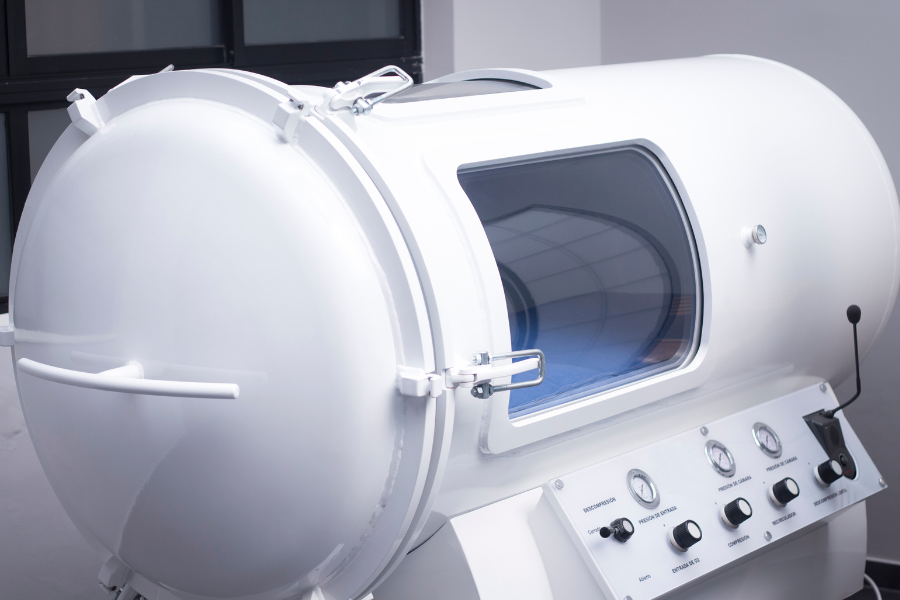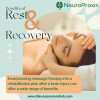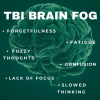Hyperbaric oxygen therapy (HBOT) is a form of oxygen therapy that involves breathing pure oxygen in a sealed and pressurized environment or chamber. The air pressure the individual breathes is 2 to 3 times more pressurized, allowing the individual to intake more oxygen into their lungs than the average amount. This allows the blood to receive and carry more oxygen throughout the body which may providing benefits such as improving wound healing through the release of growth factors and stem cells, immunity, mental functioning, and a variety of other benefits (e.g., improving sleep and stress).
Hyperbaric oxygen therapy has been used on health conditions such as traumatic brain injuries, brain abscess, burns, and other diagnoses. It has also been used to help treat ischemia (inadequate blood supply to parts of the body), hypoxia (inadequate oxygen in the tissues), and cerebral edema (swelling/fluid in the brain) and reduce intracranial pressure to prevent secondary complications that develop and may worsen after a TBI. It can also be used to benefit the body on a cellular level such as improving metabolism and decreasing cell and tissue damage or death, commonly seen as secondary brain damage. Oxygen levels are also crucial for the healing process after a BI and for the brain’s neuroplasticity, a term for the brain being able to form new neural connections when other connections have been damaged. Additional research has shown the following benefits and risks:
| Additional benefits from research
(Benefits depend on dosage and duration of HBOT) |
Additional risks and concerns from research |
(Huang & Obenaus, 2011)
(American Friends of Tel Aviv University. 2020)
(Harch, Andrews, Fogarty, Lucarini, & Van Meter 2017)
(Efrati et al. 2013) |
|
References:
Mayo Clinic Staff. (n.d.). Hyperbaric oxygen therapy. Mayo Clinic. https://www.mayoclinic.org/tests-procedures/hyperbaric-oxygen-therapy/about/pac-20394380
Wang, F., Wang, Y., Sun, T., & Yu, H. (2016). Hyperbaric oxygen therapy for the treatment of traumatic brain injury: a meta-analysis. Neurological Sciences, 37(5), 693-701. http://dx.doi.org.westcoastuniversity.idm.oclc.org/10.1007/s10072-015-2460-2
FlintRehab. (2020). Hyperbaric Oxygen Therapy for Brain Injury: What Does the Science Support. https://www.flintrehab.com/hyperbaric-oxygen-therapy-for-brain-injury/
Liu, S., Shen, G., Deng, S., Wang, X., Wu, Q., & Guo, A. (2013). Hyperbaric oxygen therapy improves cognitive functioning after brain injury. Neural Regeneration Research, 8(34), 3334-3343. http://westcoastuniversity.idm.oclc.org/login?url=https://www-proquest-com.westcoastuniversity.idm.oclc.org/docview/2382784721?accountid=162765
Huang, L., & Obenaus, A. (2011). Hyperbaric oxygen therapy for traumatic brain injury. Medical gas research, 1(1), 21. https://doi.org/10.1186/2045-9912-1-21
Harch, P., Andrews, S., Fogarty, E., Lucarini, J., & Van Meter, K. (2017). Case control study: Hyperbaric oxygen treatment of mild traumatic brain injury persistent post-concussion syndrome and post-traumatic stress disorder. Medical Gas Research, 7(3). http://dx.doi.org.westcoastuniversity.idm.oclc.org/10.4103/2045-9912.215745
American Friends of Tel Aviv University. (2020). New hyperbaric oxygen therapy protocol can improve cognitive function of older adults: Research published today in peer-reviewed journal Aging. ScienceDaily. www.sciencedaily.com/releases/2020/07/200715123143.htm
Efrati S, Fishlev G, Bechor Y, Volkov O, Bergan J, Kliakhandler K, et al. (2013) Hyperbaric Oxygen Induces Late Neuroplasticity in Post Stroke Patients – Randomized, Prospective Trial. PLoS ONE 8(1): e53716. https://doi.org/10.1371/journal.pone.0053716
https://www.medicalnewstoday.com/articles/313155
https://www.myhdiet.com/healthnews/ampm/essential-health-benefits-of-having-oxygen-rich-blood/



